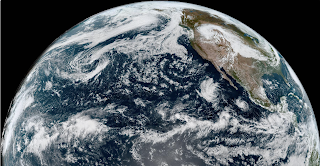- Sunrise and sunset:
- 6:43 AM sunrise
- 6:33 PM sunset
- less than 12 hours of sunlight if you hadn't noticed...
- Water is still holding on to 70 give or take
- And tides are straightforward this weekend:
- 2' at sunrise
- 5.5' mid-day
- down to 0.5' at sunset
Let's start with the basics. How do rain droplets form? The clouds floating overhead contain water vapor and cloud droplets, which are small drops of condensed water. These droplets are way too small to fall as precipitation, but they are large enough to form visible clouds. Water is continually evaporating and condensing in the sky. If you look closely at a cloud you can see some parts disappearing (evaporating) while other parts are growing (condensation). Most of the condensed water in clouds does not fall as precipitation because their fall speed is not large enough to overcome updrafts which support the clouds.
For precipitation to happen, first tiny water droplets must condense on even tinier dust, salt, or smoke particles, which act as a nucleus. Water droplets may grow as a result of additional condensation of water vapor when the particles collide. If enough collisions occur to produce a droplet with a fall velocity which exceeds the cloud updraft speed, then it will fall out of the cloud as precipitation. This is not a trivial task since millions of cloud droplets are required to produce a single raindrop. A more efficient mechanism (known as the Bergeron-Findeisen process) for producing a precipitation-sized drop is through a process which leads to the rapid growth of ice crystals at the expense of the water vapor present in a cloud. These crystals may fall as snow, or melt and fall as rain.
Now that's what's SUPPOSED to happen in San Diego- to the tune of 10+" or rain a year. But as our 'rainy' season concludes tomorrow (the timeframe is October 1st to September 30th), we ended on a low note- our 3rd straight year of drought. So just how bad was it? Let’s take a look at the final tallies:
- Newport Beach: 6.92” of rain, normal is 11.18”. Only 63% of average
- Oceanside: 7.15” of rain, normal is 11.86”. Only 62% of average
- San Diego: 6.08” or rain, normal is 9.45”. Only 64% of average
On the flip side, Hurricane Ian in Florida the past few days has been one of the biggest to ever hit the state. Officials are still assessing the damage, but preliminary reports are:
- Sustained winds of over 140 mph before it hit the central west coast of Florida
- Storm surge of 6-8'
- Over 15” of rain in some locations
- And the size of the storm was enormous as it covered a majority of the state of Florida
- The wind was blowing so hard in some locations, that it was pushing water out of bays and it looked like a negative tide or what happens before a tsunami arrives
- As the storm formed south of Cuba, the swells it created were blocked by the island- so there wasn’t a lot of waves initially in Florida as Ian approached. But as the storm cleared Cuba and raced towards Florida, in a short span of time and limited fetch area, swells jumped from 0 to 25’ within the day.
- Storm surge was also a massive problem as the Florida coastline is low lying. For comparison’s sake, we’ve had a few El Nino storms over the years in which 2” of rain causes a good amount of flooding (Mission Valley comes to mind). Now think if the flooding was a storm surge instead, and it was in the range of 6-8’. Unimaginable.
- And a common occurrence here in southern California is the dreaded upwelling. NW winds will blow along our SW shores, push the warmer top layer of water back, and up comes the colder water. This summer we had some drastic 15 degree swings in a week. With Hurricane Ian yesterday, Florida also had a drop of water temps with some locations dropping upwards of 7 degrees in 1 day.
Michael W. Glenn
Mystifying
Got The Hamburglar In My Happy Meal
Still Use Paraffin 'Cause My Surfing's So Hot

























































